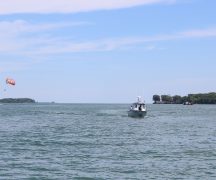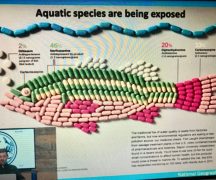By DAVID DUPONT
BG Independent News
Researchers from BGSU are traveling halfway around the globe to seek answers for the harmful algae blooms that plague Lake Erie.
HABs are a worldwide problem, including in Lake Victoria in central Africa. George Bullerjahn and Mike McKay, members of the biological sciences faculty who have been involved in studying harmful algae blooms, are traveling to Kisumu, Kenya this week to lead a three-week comparative study of harmful algae blooms.
These blooms occur around the world, said Bullerjahn, who serves as the director of the Great Lakes Center for Fresh Waters and Human Health.
“The lake doesn’t freeze, so it’s different than Lake Erie, but it has many of the same toxic cyanobacteria that we see over here.”
One the questions behind the comparative study is: “Are the microbes associated with the bloom similar or different? Can we ultimately, by studying two different lakes in very different places that have similar kinds of blooms, can we develop universal rules about how these thing form?”
A trip to Kenya in 2018 laid the foundation for this study. Working with Kisii University and the Kenya Marine and Fisheries Research Institute, he said, “we came up with some research priorities that would be the heart of a grant proposal we wrote and was funded.”
The National Science Foundation provided about $400,000.
Nine graduate students developed research projects to conduct in Kenya. Three – Ryan Wagner, Kate Brown and Katie Barker – are studying aquatic microbiology at BGSU. The other six are from the University of Wisconsin, University of Tennessee, University of Minnesota-Duluth, James Madison University, University of Windsor and Kent State University.
Their projects were developed within the context of the earlier discussions with Kenyan researchers. They will work with those scientists and students on Lake Victoria.
The bloom occurs within a gulf on the southern end of the lake. Like the western basin of Lake Erie, it is shallow with a large flow on nutrients coming in.
As with Lake Erie, agricultural runoff is a culprit in the blooms. However, Lake Victoria also has pollution coming from poor sanitation with sewage entering the lake.
“If you look at the water look like green paint,” Bullerjahn said. It appears to be all one organism. But it is not.
“It can be a lot of different related cyanobacteria plus a whole boatload of other bacteria that help the bloom form. So the ones that help the bloom form, are they similar around the world? We don’t know that,” he said. “That’s the kind of thing we’re trying to figure out.
How does that community of organisms function?
That’s one of two mysteries facing scientists research the harmful algae blooms.
The other is “whether we can predict how toxic blooms will get,” he said.
Bullerjahn is hoping to travel further into the lake where the water is cleaner to collect samples for comparison.
While the research will take place over three weeks, Bullerjahn will return a week early. He has work with the Department of Natural Resources, continuing to look for HAB solutions closer to home



